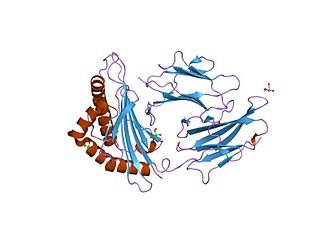Galanin receptor 2, (GAL2) is a G-protein coupled receptor encoded by the GALR2 gene. [5]
Galanin receptor 2, (GAL2) is a G-protein coupled receptor encoded by the GALR2 gene. [5]
Galanin is an important neuromodulator present in the brain, gastrointestinal system, and hypothalamopituitary axis. It is a 30-amino acid non-C-terminally amidated peptide that potently stimulates growth hormone secretion, inhibits cardiac vagal slowing of heart rate, abolishes sinus arrhythmia, and inhibits postprandial gastrointestinal motility. The actions of galanin are mediated through interaction with specific membrane receptors that are members of the 7-transmembrane family of G protein-coupled receptors. GALR2 interacts with the N-terminal residues of the galanin peptide. The primary signaling mechanism for GALR2 is through the phospholipase C/protein kinase C pathway (via Gq), in contrast to GALR1, which communicates its intracellular signal by inhibition of adenylyl cyclase through Gi. However, it has been demonstrated that GALR2 couples efficiently to both the Gq and Gi proteins to simultaneously activate 2 independent signal transduction pathways. [5]

Galanin is a neuropeptide encoded by the GAL gene, that is widely expressed in the brain, spinal cord, and gut of humans as well as other mammals. Galanin signaling occurs through three G protein-coupled receptors.
The galanin receptor is a G protein-coupled receptor, or metabotropic receptor which binds galanin.

The secretin receptor is a protein that in humans is encoded by the SCTR gene. This protein is a G protein-coupled receptor which binds secretin and is the leading member of the secretin receptor family, also called class B GPCR subfamily.

The germ cell nuclear factor (GCNF), also known as RTR or NR6A1, is a protein that in humans is encoded by the NR6A1 gene. GCNF is a member of the nuclear receptor family of intracellular transcription factors.

The neuromedin B receptor (NMBR), now known as BB1 is a G protein-coupled receptor whose endogenous ligand is neuromedin B. In humans, this protein is encoded by the NMBR gene.

The gastrin-releasing peptide receptor (GRPR), now properly known as BB2 is a G protein-coupled receptor whose endogenous ligand is gastrin releasing peptide. In humans it is highly expressed in the pancreas and is also expressed in the stomach, adrenal cortex and brain.

The prolactin-releasing peptide receptor (PrRPR) also known as G-protein coupled receptor 10 (GPR10) is a protein that in humans is encoded by the PRLHR gene.

The cholecystokinin B receptor also known as CCKBR or CCK2 is a protein that in humans is encoded by the CCKBR gene.

Pituitary adenylate cyclase-activating polypeptide type I receptor also known as PAC1, is a protein that in humans is encoded by the ADCYAP1R1 gene. This receptor binds pituitary adenylate cyclase activating peptide.

Somatostatin receptor type 5 is a protein that in humans is encoded by the SSTR5 gene.

Corticotropin-releasing hormone receptor 2 (CRHR2) is a protein, also known by the IUPHAR-recommended name CRF2, that is encoded by the CRHR2 gene and occurs on the surfaces of some mammalian cells. CRF2 receptors are type 2 G protein-coupled receptors for corticotropin-releasing hormone (CRH) that are resident in the plasma membranes of hormone-sensitive cells. CRH, a peptide of 41 amino acids synthesized in the hypothalamus, is the principal neuroregulator of the hypothalamic-pituitary-adrenal axis, signaling via guanine nucleotide-binding proteins (G proteins) and downstream effectors such as adenylate cyclase. The CRF2 receptor is a multi-pass membrane protein with a transmembrane domain composed of seven helices arranged in a V-shape. CRF2 receptors are activated by two structurally similar peptides, urocortin II, and urocortin III, as well as CRH.

Galanin receptor 1 (GAL1) is a G-protein coupled receptor encoded by the GALR1 gene.

Neuropeptide Y receptor type 2 (Y2R) is a member of the neuropeptide Y receptor family of G-protein coupled receptors, that in humans is encoded by the NPY2R gene.

Shekel Somatostatin receptor type 3 is a protein that in humans is encoded by the SSTR3 gene.

Somatostatin receptor type 4 is a protein that in humans is encoded by the SSTR4 gene.

Galanin receptor 3 (GAL3) is a G-protein coupled receptor encoded by the GALR3 gene.

Neuropeptide FF receptor 2, also known as NPFF2 is a human protein encoded by the NPFFR2 gene.

G-protein coupled receptor 3 is a protein that in humans is encoded by the GPR3 gene. The protein encoded by this gene is a member of the G protein-coupled receptor family of transmembrane receptors and is involved in signal transduction.

Vasoactive intestinal polypeptide receptor 1 also known as VPAC1, is a protein, that in humans is encoded by the VIPR1 gene. VPAC1 is expressed in the brain (cerebral cortex, hippocampus, amygdala), lung, prostate, peripheral blood leukocytes, liver, small intestine, heart, spleen, placenta, kidney, thymus and testis.

Ryanodine receptor 3 is one of a class of ryanodine receptors and a protein that in humans is encoded by the RYR3 gene. The protein encoded by this gene is both a calcium channel and a receptor for the plant alkaloid ryanodine. RYR3 and RYR1 control the resting calcium ion concentration in skeletal muscle.
This article incorporates text from the United States National Library of Medicine, which is in the public domain.